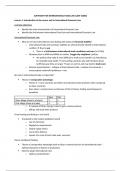Samenvatting
Summary International Food Law LAW-31806
GRADE: 9. This document is a summary of the course International Food Law (LAW-31806). It includes lectures 1 through 14. Please note that this summary was written during the 2023/2024 academic year, and the content may have changed since then. Therefore, consider these documents as supplementary s...
[Meer zien]




